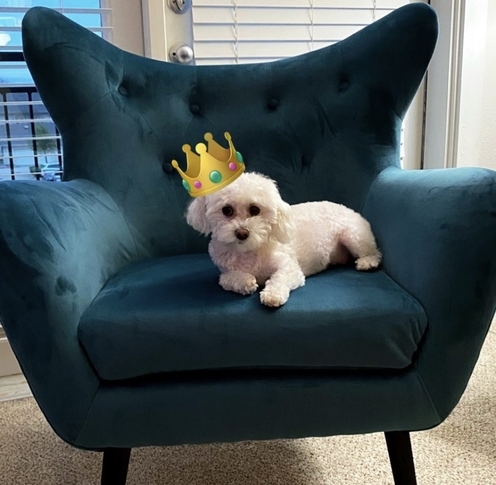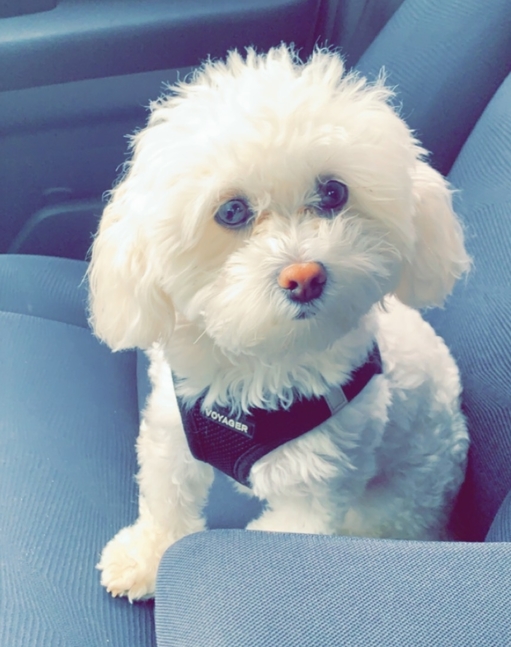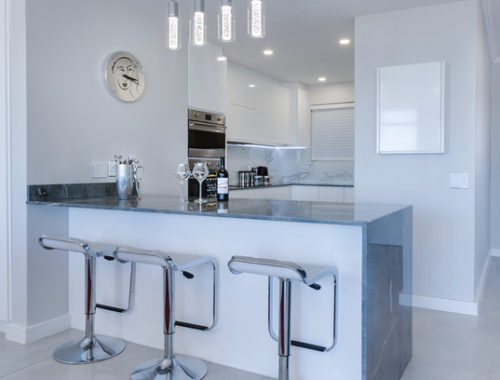
Puppy Training 101: How to Train Your Puppy
I paid an experienced dog trainer $600 for puppy obedience and house training and I’m sharing all of the details with you! Keep reading to learn how to train your puppy.
*This post contains affiliate links.
Background:
I have a one and half year old puppy, Demi. She’s super cute, playful, and loves people! When I got Demi, she was five months old and I was living in a third-floor walkup apartment.
It was really hard to potty train her, as I wasn’t home 24/7 to watch her. The method that I chose to use was a training pad…worst mistake ever! Although it was extremely beneficial during the time, it was extremely hard to potty train her because of it. It was also really gross, all the time.
Besides a few minor behavioral issues and potty training, Demi is a great pup! She does bark and whine a little when I leave the house, but her overall obedience is not bad.
Fast Forward A Year:
I spent the last few months in Dallas at my parent’s house. After consecutive weeks of Demi peeing and pooping in the house when we weren’t looking, I decided I was tired of my mom yelling and decided to get a trainer!
Moreover, I figured it was the perfect time to do so because I wanted to also get more experience on helping Demi with some behavioral issues. I realized that although Demi loved me before, her obsession with me was amplified by 100. Although that sounds cute and totally normal, it actually gives her a lot of anxiety every time I leave the house and I hate knowing that she gets stressed when I’m not around.
So I Got A Trainer:
These are the things I wanted to train my puppy on:
- Basic obedience training
- Potty training:
- Barking excessively
And boy, did I learn how to do it!
How to Train a Puppy:
(From an experienced dog trainer)
First Lesson: Do. Not. Give. Treats. (for Tricks)
No treats for tricks! When I took away the treats, I was shocked to see that Demi didn’t know the command “down” and didn’t sit every time I asked her to.
When the trainer would have Demi sit/stay/come, she would give her a ton of verbal praise and encouragement (and a lot of cuddles) when she listened instead. Weirdly, it did the trick (no pun intended)! Ever since that day, Demi has never needed treats to do tricks.
Second Lesson: The Basic Commands
The basic commands every dog should know are “sit, stay, down, and come.” Most trained dogs do know these…and Demi did before too (for the most part). But she got even better with training.
The trainer made me walk around the house (and later, outside) for most of the sessions we had together. Demi would be on the left side, while I would hold the 6 foot leash loosely. Here’s how I was taught to do each command:
All commands: Need to be done in a certain tone. With negative commands like “sit” and “stay”, you need to be confident with your tone. Make sure you don’t have a sing-song voice (I accidentally was doing that) and that you’re sharp and affirmative with your words. With positive commands like “heel” and come” you need to use your “happy voice” and pretend like it’s the best thing in the world that your dog is coming to you.
Basic Command #1: Heel
In a pattern, you eventually follow this sequence: Heel, Sit, Down, Stay, Come. Repeat. x100.
Heel: When you’re ready to start walking your dog, say “Demi, heel!” in a really excited and upbeat tone. I almost sing it! When you say “heel,” you should start walking and loosely hold the leash. If your dog doesn’t follow, give the leash a pull. You want her to follow your lead! If she walks ahead of you, give the leash a tug to correct her and make sure she is to the left side of you or slightly behind. You are the leader!
Basic Command #2: Sit
Sit: When you’re ready for your dog to sit, you need to stop walking first, and make sure your dog stays either directly to the side of you or slightly behind. If they go in front of you or don’t sit, you give the leash a tug to tell them to stay behind or force them to stop walking. Once you physically stop, you say “Demi, Sit.” Walk around about 10 more times and repeat the same exact motion (Heel–>Sit).
When you keep doing this, you probably won’t have to say “sit” anymore and they’ll just know. Eventually, your dog will be more obedient because they know that they need to follow your lead! Learning this command is the key to unlocking the rest of the commands and will help you train your puppy faster.
TIP: Your body language matters. Make sure you’re not facing your dog when you say sit. Focus straight ahead, your dog should be on your left side.
Basic Command #3: Down
Apparently the command “down” is the hardest command for a dog to learn (without treats) because they’re the most submissive in that position. And “down” doesn’t really appeal to Demi, who only likes to follow rules when she feels like it…but I got her to start learning to do that too!
Down (Optional): When you’re ready to say “Demi, down!” your dog should be sitting. While your dog is sitting, slowly walk in front and face your dog. Try pointing to the floor right underneath your dog. If your dog doesn’t lay down, bring the leash in and towards the floor (not towards you!). You basically have to push them gently down backwards until they’re laying down. Your dog will probably resist the first few times, until she’s comfortable with the position. When they lay down successfully, have a party and say good job and pet them a lot.
This was extremely hard for Demi to get, and we’re still working on having her do it on command. She’ll only do it if I guide her!
TIP: Only have a party when you’re completely done with the series. If your training series stops at “down” then you can have a party. If it stops after “stay” or “come”, then you need to wait until then! Having a party and saying “good job” ultimately ‘releases’ your dog.
Basic Command #4: Stay
Stay: Your dog should only “stay” once she’s either sitting or in a laying down position. When you’re ready for your dog to stay, slowly walk in front and face your dog. Put your hand out as if you’re saying “stop” and say “stay.” Don’t release your hand until the command is over, but you can point your finger (instead of “stop”) and hold your dog’s gaze instead. Once your dog can stay successfully, you can take one step backwards, slowly, and hold their gaze. Keep doing this until you have to let go of the leash. Slowly put the lease down without dropping eye contact. Put the leash down, and keep walking slowly backwards (one step at a time), with your finger still pointed. After a little bit, you can slowly return back to your dog.
TIP: According to the trainer, you’re only supposed to say the actual word “stay” once. After that, it’s all eye contact and pointing. If you believe that your dog can do it, she will!
Basic Command #5: Come
Come: Instead of walking back to your dog, you can say “Demi, come!” in a happy sing song voice and pat your knees as a signal. If they don’t come running to you, be even more excited. Make it sound like they’re missing out on the best party of their lives! Once they come to you, have an even bigger party and make sure you say good job and pet them!
Basic Command Review:
Train your puppy on these 5 commands and you will notice that they really start listening to you!
Third Lesson: Leash is Life & Fourth Lesson: Controlling the Bark
The trainer made me buy a 6 foot leash, rather than the expandable leash I had. And this leash was a guide to success. Every time Demi would do something we didn’t like, such as bark excessively when someone comes through the door, we would give a tug on the leash and say “NO” in a sharp voice. Emphasis on the “n”, she would kind of extend it out like “Nnnnn…O!” It was sharp and even makes me feel like I’m doing something wrong!
TIP: Here is the shorter leash I bought to train my puppy. It’s great and only $6!
I still kept the expandable leash and used it in other ways. Per the trainer’s instructions, especially when it comes to house training, puppies that are not house trained should be watched at all hours of the day. If I’m working, she is on the leash. I would give the leash a long range and then tie it to one of our table legs. She had plenty of room to walk and run around but couldn’t leave the main area, so that I could always watch her and see what she’s doing. THIS WAS THE KEY TO SUCCESS in potty training her, and I can guarantee that if you do this, you will also be able to potty train your puppy!
TIP: Here is the expandable leash I use while I’m in the house.
TIP: Here is the collar I bought!
Keeping the expandable leash on at most times was especially useful since Demi is not crate trained—another mistake I made when I first got Demi! If your dog has a crate, you could use that instead of the leash. But if you want them to have more freedom while you’re at home, you can use the leash!
Fifth Lesson: Crate Training Makes Potty Training Easier
Just wanted to reiterate that if you’re able to use a crate…use it! This is the easiest way to train your puppy. Unfortunately, Demi was never crate trained and I never tried to get her used to a crate, so she still does not one use one today. I can’t advise on the process, but I did ask my trainer for tips if I did want to start crate training her, so that I can put her in a safe place while I’m out.
She did advise that you can slowly accustom dogs to the crate. Feed meals in the crate, always put treats in the crate, and only crate her starting for a few minutes at a time. It can take weeks or months for the dog to get adjusted, but they’ll consider it their safe space eventually.
I’ve started doing this and hope for the best!
TIP: Here is the crate I bought.
SHAMELESS PLUG: If anyone has any experience with this, please comment below, I’d love to learn from you!
Sixth Lesson: How to Potty Train
I have read so many articles about potty training puppies and how to do it…but Demi kept making mistakes in the house regardless of what I would do. She would have an accident once a week, on pattern. It was always when I wasn’t watching and when it was extremely unexpected (of course). Naturally, I wanted to keep more of an eye on her, hence the leash tying. But what really made the difference was creating a routine. Here’s how you can potty train your puppy!
Morning Routine
Per the trainer’s instructions, it’s best to take dogs out in the morning right when you wake up and in the evening right before you go to sleep. I started taking Demi out on a quick 2 minute walk almost immediately after I wake up. I quickly change and brush my teeth and then head out the door. It’s not a real walk—it’s literally just for her to do her business. I only have to walk her about two short streets and then she’s all done. I take her back in the house and she’s good to go.
Taking her out in the morning changed my life! This is definitely something you need to try if you want to fully train your puppy. Most dog owners do this—but I go on about a 35 minute walk every evening with Demi, and shes completely exhausted after, so I tend to just stick with that. The 2 minute morning walk guarantees that she’s completely done until later, so it gives me reassurance.
After the walk, I’ll feed Demi her first meal (out of two meals). Once she’s done eating, I don’t take her out. However, all dogs are different. After monitoring Demi for months, I realized that she doesn’t need to go out after she eats as long as she goes out before, she takes a while to digest!
Afternoon Routine
Here’s the tricky part. You have to time your dog to see when she naturally needs to go to the bathroom, especially if they’re not a really young puppy. Mine being really delayed in training here, she could hold it for about four hours. So at the four hour mark, I would take her out. And with everyday that passed, I would extend it 30 minutes to an hour. Weirdly, she went through this stage pretty quickly (in one week) and now holds it for 8 hours.
However, with COVID, I’ve been working from home and watching her throughout the day. When she’s inside and I’m home, she’s always on a leash. The only time I take her off the leash is when I have to leave the house or when I’m in the shower, and I always take her for a quick 2 minute walk before I leave. The one time I didn’t take her out before I left, she had an accident in the house…so now I always do. It’s not on the puppy if they make a mistake…it’s on you! Own it and adapt your actions to give the results you’re looking for.
Evening Routine
After the 8 hour period has passed, I’ll take her outside. Usually that’s around 5-6 oclock. I’ll feed her at 7, and then we go on our 35 minute walk. After that I can shower peacefully, knowing she’s done her business and is basically done for the day.
She’s never had an accident overnight and knows to hold it until I take her out in the morning. If your dog has accidents overnight, I would make sure to take them as the last thing you do before you go to sleep, and the first thing you do in the morning.
Moral of the Story: Keep Up With The Routine!
Following this procedure everyday allowed Demi to rely on the schedule…If you want to fully train your puppy, they need to know you’re going to take them out and wait until you do. It worked like a charm and within the three weeks the trainer told me to do this, she was trained!! Magic!
Seventh Lesson: Reducing Separation Anxiety
Every time I would leave the house, Demi would bark and whine like crazy. My mom would say “Demi is howling again”…mind you, she’s an 8 pound maltipoo puppy.
So we practiced this. I would leave the house for a few minutes, set a timer on my phone to track how long I was gone, and would renter the house. Every time I re entered, I was told to ignore Demi until she completely calmed down. The purpose of this was to reduce her anxiety as people enter and leave. Basically meaning—remove the hype, to have a calm dog. I was told to never say “hi” or “bye” so that those cues aren’t used as warnings that people are coming or leaving.
If you decide to try this, you should increase the intervals you’re going outside for. If your dog barks, you should say “No bark” to them and then ignore them until they calm down. But, the goal should be essentially coming back before they bark, so that the training is more focused on positive behaviors and rewarding your dog when they do a good job. That seemed to help Demi, so I would highly recommend it!
Surprisingly, even though we didn’t practice this a million times, Demi got better! After about three training sessions (each for one hour where we practiced multiple things), both my parents and my sisters told me that she’s massively improved. Instead of howling, she would just cry and whine for a few minutes and then retreat to another area until I come back.
Results
Overall, Demi improved significantly during the six sessions I had with the trainer. Could I have done some of it myself? Probably! But I was fed up and wanted expert advice that I could apply quickly. I also learned a lot about my tone of voice, how to edit commands based on the situation, and being more controlling over each situation.
Before these trainings, Demi controlled me. Now, I control her!






